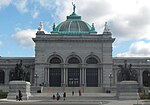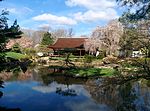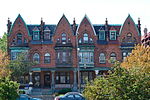West Philadelphia
Neighborhoods in PhiladelphiaWest PhiladelphiaWikipedia indefinitely semi-protected pages

West Philadelphia, nicknamed West Philly, is a section of Philadelphia, Pennsylvania. Though there is no official definition of its boundaries, it is generally considered to reach from the western shore of the Schuylkill River, to City Avenue to the northwest, Cobbs Creek to the southwest, and the SEPTA Media/Wawa Line to the south. An alternate definition includes all city land west of the Schuylkill; this would also include Southwest Philadelphia and its neighborhoods. The eastern side of West Philadelphia is also known as University City.
Excerpt from the Wikipedia article West Philadelphia (License: CC BY-SA 3.0, Authors, Images).West Philadelphia
Belmont Avenue, Philadelphia
Geographical coordinates (GPS) Address Nearby Places Show on map
Geographical coordinates (GPS)
| Latitude | Longitude |
|---|---|
| N 39.975709 ° | E -75.2129 ° |
Address
Belmont Avenue 1372
19104 Philadelphia
Pennsylvania, United States
Open on Google Maps









